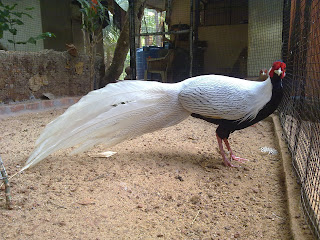Silver Pheasant
The Silver Pheasant (Lophura nycthemera) is a species of pheasant found in forests, mainly in mountains, of mainland Southeast Asia, and eastern and southern China, with introduced populations in Hawaii and various locations in the US mainland. The male is black and white, while the female is mainly brown. Both sexes have a bare red face and red legs (the latter separating it from the greyish-leggedKalij Pheasant).It is common in aviculture, and overall also remains common in the wild, but some of its subspecies (notablywhiteheadi from Hainan, engelbachi from southern Laos, and annamensis from southern Vietnam) are rare and threatened.
Description
Males of the northern subspecies, which are the largest, have white upper parts and tail (most feathers with some black markings), while their underparts and crest are glossy bluish-black. The males of the southern subspecies have greyer upperparts and tail with extensive black markings, making them appear far darker than the northern subspecies. The adult male plumage is reached in the second year.This is a relatively large pheasant, with males of the largest subspecies having a total length of 120 to 125 cm (47 to 49 in), including a tail of up to 75 cm (30 in), while the males of the smallest subspecies barely reach 70 cm (28 in) in total length, including a tail of about 30 cm (12 in). The body mass of males can range from 1.13–2 kg (2.5–4.4 lb). Females of all subspecies are notably smaller than their respective males, with a size range of 55–90 cm (22–35 in) in total length, including a tail of 24–32 cm (9.4–13 in). The body mass of females can range from 1–1.3 kg (2.2–2.9 lb).
Females are brown and shorter-tailed than the males. Females of some subspecies have whitish underparts strongly patterned with black, and in whiteheadi this extends to the upper mantle.







No comments:
Post a Comment